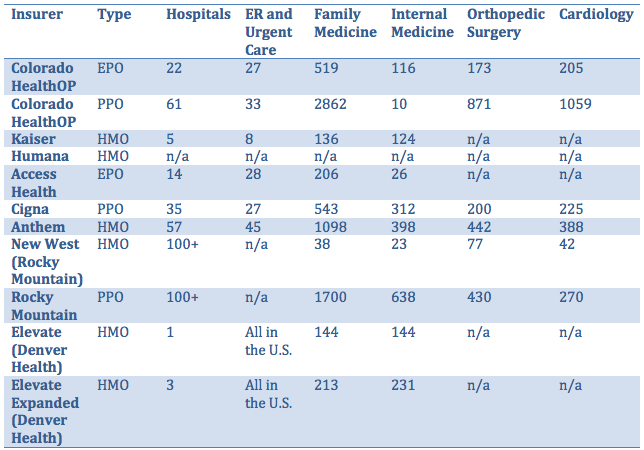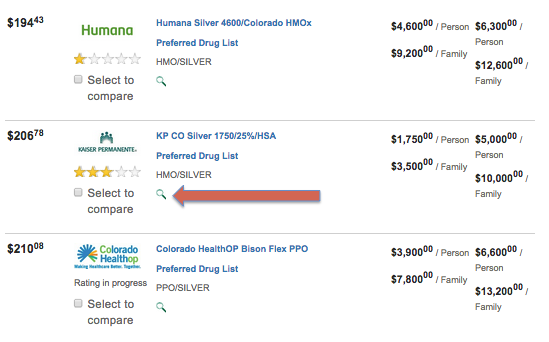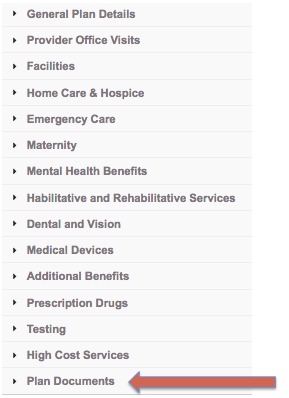Get a First Look at 2015 Colorado Insurance Plan Provider Networks
by Matthew Valeta, Amber Burkhart
How many hospitals are in my network?
Is my obstetrician in the network?
Which hospitals are in my network?
How many pediatricians can I choose between for my kids?
These are important questions consumers are asking when they shop for an insurance plan. If consumers choose insurance with a narrower network and seek care outside of their health plan’s network (whether intentionally or not), they could end up owing a greater share of the cost. One of the new features this year on Connect for Health Colorado is the Provider Network Summary. Insurers have reported on the number of hospitals, primary care providers, and specialty care providers in their networks. CCHI has looked through the plans to make an apples-to-apples comparison of networks between insurers where it is possible. Take a look at the raw data in all its glory here.
Here are some examples of what the Provider Network Forms look like:
Here is a brief summary of networks for plans on C4HCO in Denver:

Here is a brief summary of networks for plans on C4HCO in Grand Junction:

Here is a brief summary of networks for plans on C4HCO in the West Rating Region (e.g. Moffat, Garfield, Delta, Eagle, Pitkin, Summit, La Plata, etc.):

At first glance, a couple key findings about the networks stand out:
- The number of in-network hospitals can range from 1 (Elevate) to over 100 (Anthem BCBS).
- An HMO plan does not necessarily mean that a network is small. Kaiser’s HMO network in Denver has 5 hospitals, Anthem’s HMO has 57 hospitals statewide, and Rocky Mountain’s HMO has over 100 hospitals statewide in its network.
- When an insurance companies uses multpile types of networks (HMO,PPO,EPO), they can vary significantly in size.
How to Access a Provider Network Report
There are more great details in the network reports themselves. Depending on the insurer, you can look up the names of hospitals, emergency care and urgent care facilities, specialty care facilities, pharmacy providers, and the geographic service area of the plan. You can access this document in the plan documents section of C4HCO. After you make it to the main shopping page, click on the magnifying glass.

Then select, “plan documents”

Then find the provider network form

What is a Narrow Network? Are Narrow Networks Bad? What is the Right Network?
There is not necessarily a ‘goldilocks zone’ where networks will be just right for everyone. For some consumers, keeping premiums low is the most important factor and a smaller network is okay. For someone else a certain hospital for surgical facility could be incredibly important. As long as there is transparency about the networks, consumers can compare plans and make the choice that meets their needs.
Network Comparisons Help Us Know What We Don’t Know
While having access to 2,862 family medicine providers (Colorado HealthOp PPO) is probably great, there is more information consumers need to know to make a meaningful choice. How many providers are within 5 miles of them? 10 miles? 50 miles? How many providers are accepting new patients? How do the providers in the network compare to other plans? Is it worth it to travel a little farther to see a higher quality provider? Answering questions like these is an important next step for determining whether an insurer’s network works for you. Some of these questions are not yet easy to answer, so as a state we need to find ways to empower consumers with the information they need to make these decisions simpler.
Don’t Make Any Assumptions
One important factor to keep an eye on is which hospitals in Colorado are included in which insurance plan’s network. The Robert Wood Johnson Foundation and the Urban Institute recently released a new network adequacy analysis this October of 2014 marketplace plans in six cities. Their report looked at which silver plans included the following Denver area hospitals:
- Children’s Hospital Colorado
- Denver Health Medical Center
- Exempla St. Joseph Hospital
- Medical Center of Aurora
- National Jewish Health
- Porter Adventist
- Presbyterian St. Luke’s Medical Center
- Rose Medical Center
- University of Colorado Hospital

Anywhere from one to nine hospitals were in network for these plans. Just like you should make sure you provider is in your network you should make sure the plan you purchase has the right combination of hospitals.
Room for Improvement
Moving forward there are several ways provider network reports could be improved. First, it is difficult to make a complete comparison of insurance plan’s networks. While some insurers have greatly helped consumers by listing every in network hospital, others have simply stated the number of hospitals in their network. A tool for comparing plans online would make it much easier for consumers to make a nuanced decision based on networks. Next, regional reporting could also help consumers make the right decision. Many plans use a statewide network regardless of where the consumer lives. Provider network reports show the same information whether a consumer lives in Durango or Frisco. Finally, Colorado should consider adopting quantitative standards for measuring health insurance networks. Being able to compare networks based on time and/or distance standards would create another meaningful comparison point for consumers.
These provider network reports are a good first step toward empowering consumers while they shop on Connect for Health Colorado, but more detailed information is needed. The last thing consumers should be subject to is surprise out-of-network costs. Being able to compare networks, just like providers or copays, could make it easier for consumers to make a decision that is right for them and their family. Ideally consumers will have a choice of both narrow and robust networks when they shop. Transparency is key for ensuring that consumers get the care that they need, when they need it.
If you had to look up any definitions for health insurance jargon while reading this blog please check out CoveredU.org. It’s a great way to catch up on how to use a health insurance plan.
